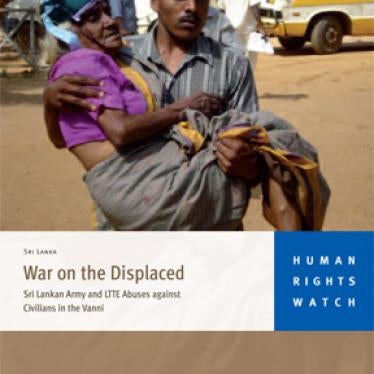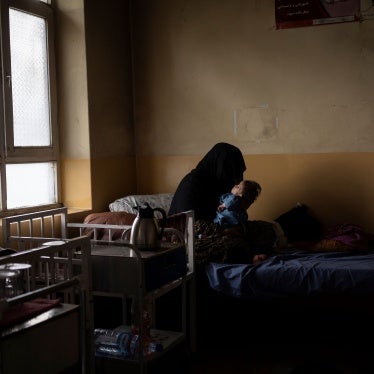(New York) - The Sri Lankan armed forces have repeatedly struck hospitals in the northern Vanni region in indiscriminate artillery and aerial attacks, Human Rights Watch said today. Commanders responsible for ordering or conducting such attacks may be prosecuted for war crimes.
Patients, medical staff, aid workers, and other witnesses have provided Human Rights Watch with information about at least 30 attacks on permanent and makeshift hospitals in the combat area since December 2008. One of the deadliest took place on May 2, when artillery shells struck Mullaivaikal hospital in the government-declared "no-fire zone," killing 68 persons and wounding 87.
"Hospitals are supposed to be sanctuaries from shelling, not targets," said Brad Adams, Asia director at Human Rights Watch. "While doctors and nurses struggle to save lives in overcrowded and underequipped facilities, Sri Lankan army attacks have hit one hospital after another."
Human Rights Watch has criticized both the Sri Lankan armed forces and the separatist Liberation Tigers of Tamil Eelam (LTTE) for numerous violations of the laws of war during the recent fighting. Tens of thousands of civilians have been held as "human shields" by LTTE forces on a narrow strip of land on Sri Lanka's northeast coast.
As Sri Lankan army forces have advanced, the LTTE has unlawfully forced the civilian population along with them in retreat. Hospital staff have increasingly been compelled to leave permanent hospitals to set up makeshift hospitals in LTTE-controlled areas. Several independent sources informed Human Rights Watch that each time a hospital was established in a new location, the doctors transmitted GPS coordinates of the facility to the Sri Lankan government to ensure that the facility would be protected from military attack. Medical staff said that, on several occasions, attacks occurred on the day after the coordinates had been transmitted.
An aid worker described to Human Rights Watch an aerial attack on Valayanmadam hospital in the no-fire zone on April 2:
"I was in the hospital. Right after 12:30 p.m., I noticed a Sri Lanka military drone conducting reconnaissance above the hospital. The people in the hospital suspected that an attack was imminent, so they lay down on the ground. Shortly thereafter, we heard a loud explosion in the air, followed by several smaller explosions on the ground. One of the explosions took place only a couple of meters from me. One of the doctors, who was lying just next to me, was killed by a shrapnel piece that hit him in the head. Four or five people were killed and more than 30 were wounded in the attack."
Medical staff said that makeshift hospitals that have been hit were clearly marked as medical facilities. For example, after repeated attacks on the hospital at Puthukkudiyiruppu, an LTTE stronghold, the hospital was evacuated to a school in Putumattalan, across the Nanthikadal lagoon in the no-fire zone. Witnesses said the hospital was marked with a large red cross on one of the buildings facing Sri Lankan army positions across the lagoon, and a red-cross flag flew at the entrance. A person who fled across the lagoon in late March told Human Rights Watch that the red-cross signs were clearly visible from the government positions across the lagoon, about a kilometer away. Yet, the hospital came under attack on several occasions.
A medical worker told Human Rights Watch that when the Putumattalan hospital came under heavy shelling around midnight on April 20, he immediately sought cover in a bunker. He described what he saw after he left the shelter early in the morning:
"The roof of the building was destroyed and tiles had fallen into the room. The operations ward had disappeared completely. There were eight dead bodies in Ward 5, and five dead bodies in the admission ward, all of them patients who had been admitted with injuries from previous attacks. Injured people were still coming to the hospital, but the medical staff was not able to provide any medical treatment. I have no idea how many dead and injured there were in total. I just counted 13 dead bodies in two of the five wards and then I left."
Since mid-February, the International Committee of the Red Cross has evacuated more than 13,000 wounded and their caregivers from the war zone by sea. Permanent and makeshift hospitals within LTTE-controlled territory continue to receive hundreds of patients daily. Many arrive wounded from the fighting, while others are sick due to inadequate sanitation, and acute shortages of food and clean water.
Witness accounts suggest that in some cases the Sri Lankan military attacks may have been targeted at LTTE forces present in the vicinity of the hospitals, yet in other cases witnesses said there were no LTTE forces anywhere near the hospitals.
Hospitals, whether permanent or temporary, are specially protected under international humanitarian law. Like other civilian structures, they may not be targeted. Under the Geneva Conventions, hospitals remain protected unless they are "used to commit hostile acts" that are outside their humanitarian function. Even then, they are only subject to attack after a warning has been given setting a reasonable time limit, and after such warning has gone unheeded. The presence of LTTE medical workers or injured combatants does not affect the civilian character of medical facilities.
LTTE forces who deploy among civilians or near hospitals are violating the laws of war by unnecessarily placing civilians at risk. However, violations by one party to an armed conflict do not justify violations by the other.
Under the laws of war, parties to a conflict must take all feasible precautions to ensure that a target of attack is a military objective and not a civilian object. Attacks that do not discriminate between military targets and civilian objects are prohibited. Individuals who order or carry out unlawful attacks willfully - that is, deliberately or recklessly - are responsible for war crimes. States are obligated under the laws of war to investigate alleged war crimes and prosecute those responsible.
"Repeated Sri Lankan artillery attacks striking known hospitals is evidence of war crimes," said Adams. "The government cannot hide behind LTTE atrocities to justify their own unlawful acts."
Human Rights Watch said Sri Lanka's key donors - including the United States, the European Union, India, Japan, and China - should strengthen calls for the Sri Lankan government to cease the use of heavy weapons in densely populated areas, particularly near hospitals. Both the government and the LTTE should permit safe humanitarian corridors to allow civilians to flee the combat zone.
Human Rights Watch reiterated its call for the humanitarian situation in Sri Lanka to be urgently taken up by a formal meeting of the United Nations Security Council in New York and by a special session of the UN Human Rights Council in Geneva.
Attacks on Hospitals in the Vanni (December 15, 2008 - May 2, 2009)
Information compiled by Human Rights Watch from interviews with aid agencies and witnesses







